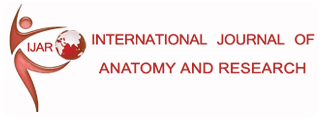IJAR.2025.114
Type of Article: Original Research
Volume 13; Issue 1 (March 2025)
Page No.: 9168-9171
DOI: https://dx.doi.org/10.16965/ijar.2025.114
Pterygospinous Bar: An Ossified Ligament at the Base of Skull and Its Clinical Importance
Vimal Gupta 1, Anshu Sharma *2.
1 Demonstrator, M.Sc. (Anatomy), Department of Anatomy, Government Medical College & Hospital, Chandigarh, India. ORCiD: https://orcid.org/0009-0007-2051-4155
*2 Professor, Department of Anatomy, Ms (Anatomy), Government Medical College & Hospital, Chandigarh, India. ORCiD: https://orcid.org/0000-0002-4389-2390
Corresponding Author: Dr. Anshu Sharma, Professor, Department Of Anatomy, Ms (Anatomy), Government Medical College & Hospital, Chandigarh, India, 160030, E-Mail: anshusharma_01@yahoo.co.in
ABstract
Introduction: Lateral pterygoid plate of Sphenoid on its upper part of posterior border usually presents a spine. This spine gives attachment to Pterygospinous ligament. Ossification of this ligament may cause compression system for the neurovascular structures.
Materials and methods: A Total of 39 human skulls present in Government Medical College, Chandigarh’s bone bank, were included in the study. Skull with complete base and lateral wall of skull were included. The presence of Pterygospinous bar, its completeness, bilaterality, and size were noted.
Result: Out of 39, three skulls had pterygospinous bar bilaterally. In these three skulls too One skull had incomplete bars bilaterally while two others had complete bar forming foramen on right side. In other two skull incomplete bars were present unilaterally. The shape of the Foramen formed by the complete bar was round in two while oval in one skull.
Conclusion: Complete ossification of Pterygospinous ligament can result in formation of a foramen through which mandibular nerve branches which can manifest as various clinical symptoms. Therefore, this knowledge is important to neurosurgeons, radiologists, maxillofacial surgeons, anesthetists along with anatomists and anthropologist
KEY WORDS: Pterygospinous Bar, Ossified Ligament , Spine, Mandibular nerve.
REFERENCES
[1]. Yadav A, Kumar B, Niranjan R. Pterygospinous Bar and Foramen in the Adult Human Skulls of North India: Its Incidence and Clinical Relevance. Anatomy Research International; 2014: 1-5
https://doi.org/10.1155/2014/286794
PMid:24963408 PMCid:PMC4055007
[2]. Nikolova S, Toneva D, Zlatareva D, Fileva N. Osseous Bridges of the Sphenoid Bone: Frequency, Bilateral and Sex Distribution. Biology. 2023; 12:492
https://doi.org/10.3390/biology12040492
PMid:37106693 PMCid:PMC10136311
[3]. Chakravarthi KK, Babu KS. An Anatomical study of the Pterygo-Alar Bar and Porus Crotaphitico Buccinatorius .Int j.med health Sci. 2012;July.1(3):1-9.
[4]. A Esen, A Özgür, Y Balcı, B Ten. Pterygospinous and pterygoalar bars in children. Surgical and Radiologic Anatomy; 2021.Volume 44, pages 353-359.
https://doi.org/10.1007/s00276-021-02853-z
PMid:34825933
[5]. R R Rosa , H Faig-Leite, FS Faig-Leite, L C Moraes, M E L Moraes, E M Filh Radiographic study of ossification of the pterygospinous and pterygoalar ligaments by the Hirtz axial technique. Acta Odontol Latinoam; 2010;23(1):63-7
[6]. Tubbs RS, May WR Jr, Apaydin N, Shoja MM, Shokouhi G, Loukas M, Cohen-Gadol AA. Ossification of ligaments near the foramen ovale: an anatomic study with potential clinical significance regarding transcutaneous approaches to the skull base. Neurosurgery. 2009 Dec;65(6 Suppl):60-4;
https://doi.org/10.1227/01.NEU.0000345952.64041.9C
PMid:19935003
[7]. Kapur E, Dilberovic F, Redzepagi S. Variation in the lateral plate of the pterygoid process and the lateral subzygomatic approach to the mandibular nerve. Medicinski arhiv 2000; 54 (3): 133-137.
[8]. Peker T, Karakose M, Anil A, Turgut HB. The incidence of basal sphenoid bony bridges in dried crania and cadavers: their anthropological and clinical relevance. European Journal of Morphology 2002; 40(3): 171-180.
https://doi.org/10.1076/ejom.40.3.171.16686
PMid:14566610
[9]. Pinar Y, Arsu G, Aktanlkiz ZA, Bilge O. Pterygospinous and pterygoalar bridges. Sendrom. 2004;16:66-69.
[10]. Antonopoulou M, Piagou M, and Anagnostopoulou S. An anatomical study of the pterygospinous and pterygoalar bars and foramina-their clinical relevance. Journal of CranioMaxillofacial Surgery 2008; 36(2) : 104-108.
https://doi.org/10.1016/j.jcms.2007.05.009
PMid:18280174
[11]. Devi JD, Mugunthan N, Anbalagan J, Sudha R, Shivadeep S. A study on ossified pterygospinous and pterygoalar ligaments in Indian skulls. Nat J Basic Med Sci. 2012;3(2):103-08.
[12]. Kamath K, Vasantha K. Anatomical Study of Pterygospinous and Pterygoalar Bar in Human Skulls with their Phylogeny and Clinical Significance. Journal of Clinical and Diagnostic Research. 2014; 8(9): 10-13.








